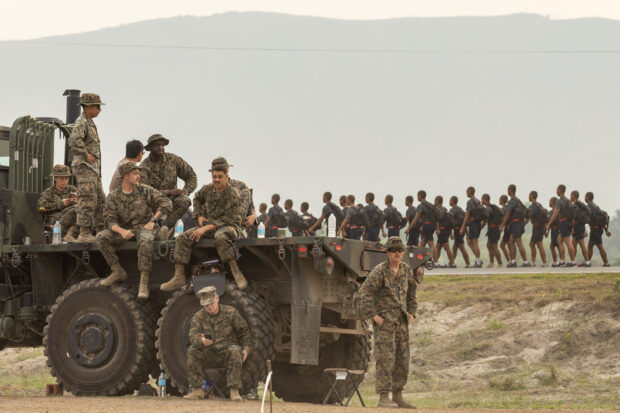After ‘Balikatan’ comes ‘Cope Thunder’ revival

U.S. troops look on as Philippine military cadets train at a naval base where the annual joint military exercises between U.S. and Philippine troops called “Balikatan” or shoulder-to-shoulder are held in San Antonio, Zambales province, Philippines, April 26, 2023. REUTERS/Eloisa Lopez
Cope Thunder started in the Philippines in 1976 but the training stopped after the US military closed its bases in Clark and Subic Bay in 1991 due to damage from the Mt. Pinatubo eruption in June that year and also after the Philippine Senate voted against extending the lease on US military facilities
The air forces of the Philippines and United States will revive a large-scale joint exercise after more than three decades to enhance the defense and readiness posture of the two treaty allies amid worries about China’s assertiveness in the region.
The exercise, dubbed “Cope Thunder,” will be staged from May 1 to May 12—just a few days after the three-week “Balikatan” concludes on Friday. The exercise will be held at Clark Air Base in Pampanga, the US Pacific Air Forces (Pacaf) said in a statement.
The 18-day joint Balikatan exercises between the two allies, so far the largest war games involving almost 18,000 troops, will wrap up today after a number of exercises that focused on the defense of the Philippine archipelago.
‘Real-world scenario’
“Cope Thunder Philippines is designed to provide bilateral fighter training with the Philippine Air Force and improve combined interoperability. Approximately 160 USAF service members are expected to fly, maintain and support more than 12 aircraft from the 35 Fighter Wing, Misawa Air Base, Japan units during this iteration of the exercise,” the Pacaf statement said.
Filipino and American airmen will exchange tactics, techniques, and procedures while improving interoperability during the training period.
The drills are expected to feature the F-16 multirole fighters of the US Air Force’s 35th Fighter Wing soaring in the skies with the FA-50 trainer jets of the Philippine Air Force (PAF) for the exercise.
“This is to prepare us for ‘real-world scenario’ in air combat,” according to a PAF official familiar with the training but was not authorized to speak to the media.
Future iterations of Cope Thunder may include participants from allied nations, the official said.
Dating back to ’70s
Cope Thunder started in the Philippines in 1976 but the training stopped after the US military closed its bases in Clark and Subic Bay in 1991 due to damage from the Mt. Pinatubo eruption in June that year and also after the Philippine Senate voted against extending the lease on US military facilities.
The exercise was then moved to Eielson Air Force Base in Alaska in 1992, and eventually called it Red Flag Alaska.
The exercise will take place as China steps up its presence around Taiwan, the Philippines’ closest northern neighbor, and its persistent encroachments in the country’s waters while harassing local ships and fisherfolk.
Beijing has also been vocal in expressing displeasure over Manila’s decision to allow US forces access to Philippine military bases in Cagayan Valley, the region closest to Taiwan, under the Enhanced Defense Cooperation Agreement (Edca).
Assurance to China
Philippine officials have tried to assure China that such access did not mean that the bases would be used as a jumping board for US intervention in the China-Taiwan conflict.
Edca allows the United States to preposition military materiel, equipment, and aid supplies for use in humanitarian missions in cases of calamities in disaster-prone Philippines.
The air force drills are also being held amid the PAF’s anticipated acquisition of a fleet of multirole fighters.
The PAF has been looking at American-made Lockheed Martin F-16 and Sweden’s Saab JAS-39 Gripen—its two shortlisted choices for fighter jets.
The high-level meeting between top diplomatic and defense officials in Washington in early April included talks on holding “focused discussions” for the sale of jet fighters, apart from the security sector assistance roadmap to support the delivery of priority defense platforms over the next five to 10 years. INQ
READ: Philippines, US to begin 2-week joint ‘Balikatan’ exercises on Monday